AMD Entry-level PC
Two years ago our Entry AMD CPU was single core, last December a bit more money bought a 2.6GHz dual-core system, and today's AMD Entry system uses a Black Edition unlocked 2.7GHz dual-core. It's great to see the increased value in an economy that forces most buyers to look closely at price.
With memory so cheap we have continued our recommendation of 4GB at a 2x2GB kit price of just $27. For this guide we now have the option of 4GB of DDR2-800 with very fast 4-4-4 timings, thanks to the continuing use of rebates as a marketing tool by memory manufacturers. You can buy 2GB and save $18, but that money is well spent in doubling memory. The hard drive remains a 500GB. Finally, the monitor choice has moved up from a widescreen 17" to a higher resolution widescreen 19" - at just $10 more than the previous $100 price. LCD prices have been dropping rapidly and monitor value improves with each new Buyers' Guide in the past year.
| AMD Entry-level PC | ||
| Hardware | Component | Price |
| Processor | Athlon X2 7750 Black Edition Kuma (Dual-core 2.7GHz, 65nm, 95W, 2x512KB L2, AM2+) |
$60 |
| Cooling | CPU Retail HSF | - |
| Video | On-Board | - |
| Motherboard | ASRock A780GMH/128M 780G AM2+/AM3 HDMI | $72 |
| Memory | Patriot Viper Model PVS24G6400LLK 4GB DDR2-800 4-4-4 ($52 less $25 Rebate) |
$27 |
| Hard Drive | WD Caviar GP WD5000AACS 500GB | $55 |
| Optical Drive | Sony Optiarc Model AD-7240S-OB 24X DVDRW SATA | $24 |
| Audio | On-Board | - |
| Case | SIGMA La Vie LBYWBP Leather Mid-Tower w/ 500W PSU ($65 less $20 Rebate) |
$45 |
| Power Supply | 500W Included with Case | - |
| Base System Total | $283 | |
| Display | Acer X193W+BD 19" 5ms Widescreen LCD (1680x1050) | $110 |
| Speakers | Cyber Acoustics CA3090WB 2.1 Gaming Speakers | $16 |
| Input | Microsoft CA9-00001 PS/2 Keyboard and Optical Mouse | $17 |
| Operating System | Microsoft Vista Home Premium SP1 (for System Builders) | $99 |
| Complete System Bottom Line | $525 | |
 |
Prices on all processors are continuing to drop with the aggressive price war between Intel and AMD in entry to upper midrange processors. The $60 Athlon X2 7750BE is a fast 2.7GHz Kuma dual-core at a price of just $60. It is not just faster than in the last guide, but it's also a Black Edition (unlocked) CPU. Most have been easily running at 3.0GHz just by increasing the multiplier. If you want even more power the new Athlon 64 7850 (2.8GHz) is a good choice at $69, or a Phenom 8750 triple-core Black Edition is a terrific value at just $27 more at $87. However, for most users the Athlon 64 X2 7750 provides plenty of power for an entry system. About the only real drawback is that the latest Athlon X2 parts are still using 65nm process technology and come from harvested Phenom chips (i.e. with two non-functional cores), so power draw will be higher than the latest 45nm parts.
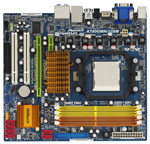 |
The 780G chipset is still going strong and manufacturers are currently updating to second-generation designs based on this IGP workhorse. One of the best second-generation 780G boards in this price category is the ASRock A780GMH/128M. ASRock has done a masterful job in updating their previous GM-LE series of boards. From the new packaging design and accessory kit components to the revised layout, we would be hard pressed to find a better value in this price range. The A780GMH/128M utilizes the AMD/ATI Radeon 3200 integrated graphics engine along with 128MB of Side Port memory to deliver excellent integrated performance. This board features the revised SB710 Southbridge that features six 3Gb/s SATA ports with RAID 0/1/10 support, 7.1 HD audio from the VIA VT1708S codec, 10 USB 2.0 ports, and Gigabit LAN with the revised Realtek RTL8111DL controller. The board has a single PCI-E x16 slot, one PCI-E x1 slot, and two PCI slots along with support for 16GB of memory. ASRock now includes three video output options with D-Sub, DVI-D, and HDMI ports all available on the I/O panel.
All current AM2/AM2+/AM3 processors are supported via an overclocking friendly BIOS. The only (minor) drawbacks with the board are the lack of IEEE 1394a capability and fan control options for the system fan headers. The quality of components utilized in the board is excellent at this price point and we have put the board through a grueling 30-day test period without any problems to date. This board is worthy of an award and we will have a complete review on it shortly, but in the meantime it carries our highest recommendation in this price category.
 |
There always seems to be some version of the Sigma mid tower with the Sigma 500W PSU on sale or rebate. The case and power supply choice for this guide is the Sigma La Vie Leather Black. This case and power supply are currently on sale for $45 after a $20 rebate. Sigma makes both decent cases and decent power supplies sold individually. While no one will mistake this case/PSU combo for one of the premium Sigma offerings, it is still good quality and good value for a very reasonable price. Even if you pay the regular price of $60 to $65 you will get good value in this combo. We have built several entry systems with the Sigma case and PSU and had good results and stable performance. The only caveat is to check out the case when it arrives as shipping can take its toll on the case front door.
If you prefer a smaller case to mate with a Micro ATX motherboard, the HEC 6K28BSOH48D mini tower with a 485W power supply is an option. It is a solid small case with a power supply form HEC, which is one of the world's best PSU makers. You should generally go for the best case and power supply you can reasonably afford, so you should also look at the cases and power supplies recommended for more expensive systems - particularly if you plan to keep your case/PSU and merely upgrade other components in the future.
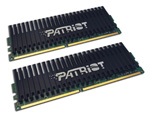 |
With DDR2 prices so very low, we went for 4GB of DDR2-800. This is double last year's entry recommendation for less than half the price. RAM prices as a whole are certainly in the commodity category. There have been small increases in memory prices the last few weeks so you may need to shop a little more for the best price. We recommend the Patriot Viper 4GB DDR2-800 CAS 4 kit, which is just $27 after mail-in rebate. This is faster than our last guide recommendation of CAS5 memory at DDR2-800. You could just as easily choose OCZ, Kingston, Corsair, Crucial, GeIL, Patriot, A-Data or any other quality brand and shop for memory based on a combination of price, timings, and the company's support reputation. Again, if you are truly pinching pennies you can save about $8 by going with 2x1GB DDR2-800 instead at $19 to $20.
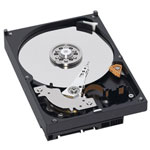 |
Hard drive capacity continues to grow, and we again selected the tried and true Western Digital Caviar 500GB for our entry system. It seems a waste to choose a lower HD capacity when 500GB is now available for under $60. While there are differences between hard drives, outside of running benchmarks most people aren't likely to notice the difference in performance between Western Digital, Seagate, Samsung, Hitachi, and other major brands. All are worthy of consideration if the price per gigabyte (or terabyte) is right.
 |
For the optical drive we went for the newest and fastest Sony 24X DVDRW. With the market moving toward Blu-ray players and 25GB/50GB Blu-ray burners, DVD writers have continued to drop in price. However, a BR player or burner is still a bit rich for an entry system. A Sony DVD writer that supports dual-layer and 24X DVD writes for $24 is a bargain indeed.
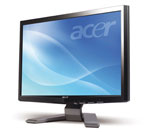 |
The last major component to discuss is the display, and here the tilt must be toward price in an entry system. $100 is a low price for an LCD monitor, but with the prices of LCD monitors dropping $110 now buys a 19" widescreen Acer monitor with a 1680x1050 native resolution. That's a decided step up from the $99 17" LCD chosen in the last Entry System Guide, and the Hanns-G was a 17" 1440x900 LCD. This Acer has the same resolution as most 22" widescreen monitors. You will not give up resolution with this monitor, but things will be a bit smaller.
If your budget allows, you can choose the 21.5" ASUS VH222H with true HD 1920x1080 resolution at $160 after a $10 rebate. 21.5"/22" True HD is today's sweet spot, since the next step up to 23.6"/24" starts around $250. If your budget can stretch to $160, that is money well spent on a 21.5" 16:9 HD wide screen display. We'll have a bit more to say about LCDs on page 4, if you're interested in discussing quality.










65 Comments
View All Comments
Hrel - Thursday, May 28, 2009 - link
Why spend 100 dollars on that card when you can get the GTS250 for 10 DOLLARS MORE?!! That's right, just 10 bucks. http://www.newegg.com/Product/Product.aspx?Item=N8...">http://www.newegg.com/Product/Product.aspx?Item=N8...Or, if you run your monitor at a stupidly high resolution for some reason, you can get the 1GB version for only 125. http://www.newegg.com/Product/Product.aspx?Item=N8...">http://www.newegg.com/Product/Product.aspx?Item=N8...
Not sure if you guys at anandtech were just unaware of this or if you really are bias against Nvidia, but the GTS250 is WAY more card for the extra 10 bucks.
dndavis57 - Saturday, May 23, 2009 - link
I've been planning something along the lines of your AMD Budget Build, to replace my deceased Athlon 64-3000 rig, so the Builder's Guide is quite timely.Question: If you're not going to use a mobo with ACC, would the Phenom II X3 710 be the value choice or is the additional speed of the 720 worth the slight ($20) price difference?
I already have a Corsair TX650W PSU, since the $80 price AMIR was too good to pass up. I had planned to reuse my original Antec Sonata, but probably will get a Sonata Elite instead ($89 at my local Micro Center). Does anyone know of any problems with this combo?
I'm thinking of swapping the mobo for Gigabyte's AM3 version, since it's only $30 more and DDR3 isn't much more than DDR2 these days. I know DDR3 doesn't make much difference on the Phenom II platform, but it may be a reasonable upgrade even if AMD can't make any changes to the existing architecture or BIOS to take better advantage of it. I just have to figure out how tight my budget truly is, since I need to build now.
Lummox - Sunday, May 24, 2009 - link
I am building something like this already. Maximum bang for buck is the BIOSTAR TFORCE TA790GX 128M, It has just about everything including two PCI-E x16 2.0 Slot (CFX x8), firewire, DVI, HDMI, VGA and the 790 and 750 chip sets. Also you can play most games with the eye candy turned off.When combined with a X2 7850 it is $129 AR of $10, which I got. This is $3 cheaper than the Entry Level, with better processor and MB.
When combined with a X2 Phenom II X3 720 it is $199 AR of $10. This is same price as the Budget Level, with better MB.
When combined with a Phenom II X4 940 it is $250 AR of $10.
When combined with a Phenom II X4 955 it is $305 AR of $10. and it is on the list of compatible MBs
All with free shipping. This is same price as the Budget Level, with better MB. The only limit On games is a Power Supply big enough for your eventual graphics card.
I you build the entry level all you need is a new PS and faster GPU, to turn it into a gaming machine. For memory, You can either buy 1066 now, upgrade later, or leave it at 600. There is not a dramatic difference between 800 and 1066.
PS all prices on NEW EGG
links
http://www.anandtech.com/cpuchipsets/showdoc.aspx?...">http://www.anandtech.com/cpuchipsets/showdoc.aspx?...
http://www.anandtech.com/cpuchipsets/showdoc.aspx?...">http://www.anandtech.com/cpuchipsets/showdoc.aspx?...
http://www.tomshardware.com/picturestory/491-pheno...">http://www.tomshardware.com/picturestory/491-pheno...
For a few bucks more the Foxconn A7DA-S has two x16 and two x8 slots. no on board video
pashbe1 - Friday, May 22, 2009 - link
Let me just start by saying Anandtech has been my hardware education. I have a question for you experts though. I spend 8-10 hours a day on 3d CAD and Rendering and maybe 15 hours a week gaming. My current rig, dont laugh, is an old dual Xeon workstation. I would really like to replace it with the mid-level AMD system that you describe in this article. Here is my concern, every ATi gpu that I have ever had to work with has had problems with the hardware acceleration in CAD. If the acceleration is maxed, the cursor prompts become a garbled box. If I set the acceleration one step down, I get a stutter in when moving around in 3d, and obviously when gaming I get a gimped cursor. So I feel compelled to stick with Nvidia, even if I have to pay a premium. Have the newer ATi cards fixed this problem? What combination of parts can I put together to come up with the performance, overclock ability, and base system price of the mid level AMD system described in this article that uses a good Nvidia card?Hrel - Thursday, May 28, 2009 - link
you should get the GTS250 from Nividia, it only costs $110 after rebate; and it's MORE card for the money. http://www.newegg.com/Product/Product.aspx?Item=N8...">http://www.newegg.com/Product/Product.aspx?Item=N8...Here's the 1GB version, since that may be helpful with CAD. Still only 125; both reliable companies.
http://www.newegg.com/Product/Product.aspx?Item=N8...">http://www.newegg.com/Product/Product.aspx?Item=N8...
PC Reviewer - Thursday, May 21, 2009 - link
first might i add that there is no such thing as "gaming speakers"no speakers are good for gaming.. the only way to go is headphones.. now obviously this is entry level but at least shell out a few more dollars for headphones if you are going to insert it with the title "gaming"
second thing is that case isnt very good. This is on sale for $54 and the quality is way better...
http://pcreviewer.org/cheap-antec-300-computer-cas...">http://pcreviewer.org/cheap-antec-300-computer-cas...
nordicpc - Wednesday, May 20, 2009 - link
Hey guys, the X2 Black Editions don't ship with a stock heatsink. Be sure to pick up a Freezer 64 or something for it.Gary Key - Wednesday, May 20, 2009 - link
The 7750 and 7850BE retail units we received from Newegg both had heatsinks.jospoortvliet - Wednesday, May 20, 2009 - link
Guys,I would love to see a few comparative benchmarks added to these systems - just to see how the entry-level Intel and AMD compare, for example...
Gary Key - Wednesday, May 20, 2009 - link
early June.. ;)